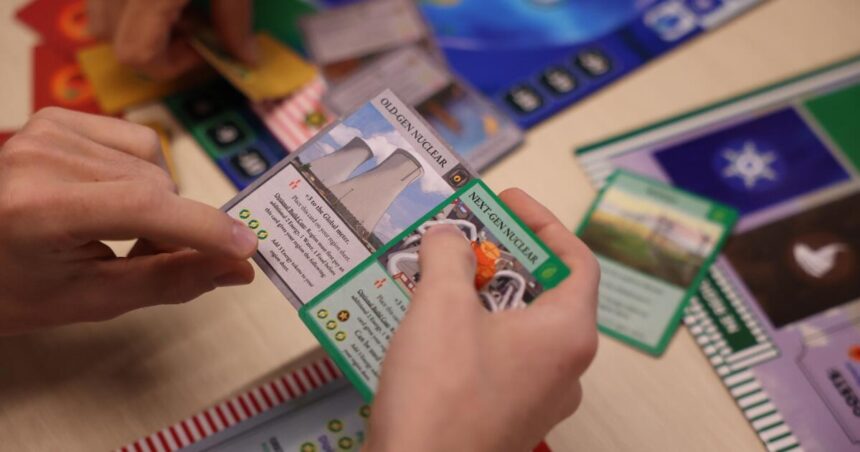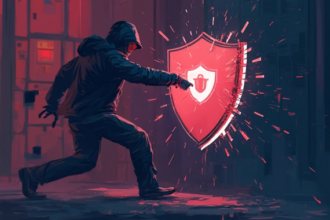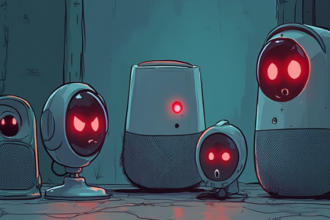What if solving the climate crisis was as easy as rolling the dice?
As a lifelong board game fan and avid environmentalist, Thomas Yount knew that these tabletop games could be more than just entertainment. They can also educate and spark conversation. Recognizing that climate change is one of the world’s most pressing issues, Yount saw that board games could be an opportunity to teach children and young people about protecting the environment.
“Historically, climate change has only come to the forefront in the last few decades,” Yount says. “Maybe there was a day of class on it, or a paragraph in a book. I think it needs to become more of a part of the curriculum.”
Yunt, who has worked as a props man and sound designer in Hollywood, began designing an environmentally themed board game more than three years ago. After finishing production on a commercial, he grabbed a leftover layout board and cut it into improvised cards, labelling each one with a natural disaster, an energy source and a climate solution. This became the basis for Climate Cooldown, an elaborate multiplayer game in which players must overcome natural disasters and invest in clean energy to save the planet from catastrophic global warming.
Climate Cooldown is one of several climate-related games that have emerged as the effects of climate change become more apparent.
Popular game maker CATAN released a new version of the classic strategy game set on a fictional island this summer. In CATAN: New Energies, players compete against each other to meet their community’s energy needs while considering the risk of pollution. Players are faced with a dilemma: whether to invest in clean, sustainable energy or choose cheaper fossil fuels that harm the environment.
“Games have the incredible power to reflect real-world challenges and spark thoughtful conversation,” said Benjamin Teuber, co-designer of New Energies.
“When we were designing this game, my father said, ‘Games are experiences, not lectures,’ so we’re not telling players the best way to act. We’re encouraging them to learn as they play and draw their own conclusions,” he said.
In NorthStar Games’ Evolution: Climate, players will create their own species and attempt to adapt to a dynamic ecosystem filled with predators, unpredictable food supplies, and fluctuating climates.
Yount has introduced Climate Cooldown to students at several private and charter schools in Los Angeles County, including REALM Creative Academy in Santa Monica, Environmental Charter Middle School in Inglewood and Alliance Leichtman Levine High School for Environmental Science in Glassell Park. The game includes cards with more than 70 environmental terms related to climate solutions, energy sources, disasters and more. But they also serve as productive conversation starters.
“When we were prototyping it, the kids were excited to be able to learn and discuss while playing a game,” Yount said. “They immediately started discussing different topics, like, ‘Is nuclear power good? I thought it was bad.’ And the teacher said, ‘Let’s take a break and discuss this.'”
Tyler Kenney, an AP environmental science teacher at Alliance High School, said one of the most effective ways to reduce emissions that cause global warming is to educate people about climate change solutions. For some students, the problem is getting them to pay attention.
“I continue to see different opportunities to gamify education,” Kenny said. “How can we take all of these important topics that we teach in schools and have very tangible consequences for an individual’s carbon footprint?”
He incorporated “Climate Cooldown” into his lesson plans last winter, not only having his class play the game but also challenging his students to think about career paths that could emerge from the climate change solutions mentioned in the game. One of his upperclassmen said the assignment inspired him to take a class at Santa Monica College on aquaculture, or the practice of farming fish.
In Climate Cooldown, players represent four regions of the world, each with different access to critical resources like electricity, water, and food. Players must allocate limited resources to new, clean energy sources and phase out fossil fuels in their region, all while keeping the global temperature below dangerous levels.
To make things even more complicated, with each round you’ll encounter disasters that put your resources at risk and threaten your strategy. Similar to the real-world global warming challenge, the most basic rule of the game is that players must work together as a team to win, or everyone loses.
“I specifically wanted the design to be collaborative because I think this is an opportunity to practice working together as global citizens,” Yount said. “We’re all going to be hit with adverse effects, climate shocks, and disasters, so being able to look out for each other during these difficult times is a really good thing to practice.”
Yount said the game helps give players a sense of agency and optimism in the face of problems that often make people feel powerless: “Kids have a tendency to think things ‘should be like this,'” he said. “This game empowers them by showing them that they can do this, that they should do this.”
“I’ve met older people who ask me, ‘Do you really think there is hope for us?’ I tell them yes. We have to be realistic, but I think it’s important that we have hope and take action together,” Yount said.
Over the summer, I enlisted three of my colleagues on The Times’ science, environment and health team – Rosanna Shea, Corinne Purtill and Noah Haggerty – to play Climate Cooldown and see what would happen to us.
As we opened the game board depicting a map of the world, we quickly realized that it was just as complex and challenging as the subject it was trying to focus on.
We each drew a card representing a fossil fuel industry that needed to leave our region. I drew oil, a card with a silhouette of a pumpjack like the one that hovers over the Englewood oil fields not far from our office. Colin and Noah drew natural gas power, and Rosanna drew coal power, the most polluting form of energy that continues to pollute Nevada and other western states.
Noah and my region had little food. In comparison, Corinne and Rosanna’s regions had plenty. However, at the start of each round, we drew disaster cards that reduced our food. Rosanna’s region was devastated by floods, Noah’s people suffered from starvation, my region was hit by earthquakes, and Corinne’s region was hit by cyclones. So we had to decide whether to spend our resources on introducing new energy sources, protecting the environment, or diplomacy.
Rosanna immediately invested in wind and nuclear, emission-free energy sources. She donated food to Noah, who dedicated resources to increasing wind and hydroelectric power. When I drew my energy card, I got a biomass power plant. Corinne put resources into nuclear power and was cool with supporting indigenous land management.
Despite early investments, we continued to inch closer to climate disaster.
But as the game progressed, we started to work together: asking for advice, donating surplus food, making decisions that benefited our common goal.
By the fourth round we were winning.
“The lesson for me is to be friends early and care about each other,” Rosanna says, “because it’s important to divest early.”









